Papers by Kathryn R. Wagner
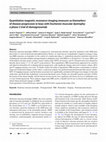
Journal of Neurology
Duchenne muscular dystrophy (DMD) is a progressive, neuromuscular disorder caused by mutations in... more Duchenne muscular dystrophy (DMD) is a progressive, neuromuscular disorder caused by mutations in the DMD gene that results in a lack of functional dystrophin protein. Herein, we report the use of quantitative magnetic resonance imaging (MRI) measures as biomarkers in the context of a multicenter phase 2, randomized, placebo-controlled clinical trial evaluating the myostatin inhibitor domagrozumab in ambulatory boys with DMD (n = 120 aged 6 to < 16 years). MRI scans of the thigh to measure muscle volume, muscle volume index (MVI), fat fraction, and T2 relaxation time were obtained at baseline and at weeks 17, 33, 49, and 97 as per protocol. These quantitative MRI measurements appeared to be sensitive and objective biomarkers for evaluating disease progression, with significant changes observed in muscle volume, MVI, and T2 mapping measures over time. To further explore the utility of quantitative MRI measures as biomarkers to inform longer term functional changes in this cohort, ...

Facioscapulohumeral Muscular Dystrophy (FSHD) is an autosomal dominant neuromuscular disease affe... more Facioscapulohumeral Muscular Dystrophy (FSHD) is an autosomal dominant neuromuscular disease affecting 1 in 20,000 to 1 in 15,000 individuals and is characterized by progressive weakness in the facial, scapular, humeral, truncal, and lower extremity muscles (Tawil and Van Der Maarel Muscle Nerve 2006). FSHD is associated with the contraction of the D4Z4 microsatellite repeat below a threshold number of repeats (Wijmenga et al., Nat. Genet, 1992), allowing the transcription of the DUX4 gene contained within the last repeat (Snider et al., PLoS Gen, 2010). The disease only develops when DUX4 is expressed from a chromosome with the permissive 4qA allele, which contains a polyadenylation signal (PAS) that stabilizes the DUX4 transcript (Lemmers et al., Science, 2010). We are using CRISPR technology to investigate the possibility that disruption of the PAS in cells derived from FSHD patients could prevent expression of the DUX4 protein and restore the cell to a less affected phenotype. W...
Supplemental Material, Gilbert-Honick_Supplemental_Information for Adipose-derived Stem/Stromal C... more Supplemental Material, Gilbert-Honick_Supplemental_Information for Adipose-derived Stem/Stromal Cells on Electrospun Fibrin Microfiber Bundles Enable Moderate Muscle Reconstruction in a Volumetric Muscle Loss Model by Jordana Gilbert-Honick, Brian Ginn, Yuanfan Zhang, Sara Salehi, Kathryn R. Wagner, Hai-Quan Mao, and Warren L. Grayson in Cell Transplantation

Sporadic inclusion body myositis (IBM) is the most common acquired muscle disease in adults over ... more Sporadic inclusion body myositis (IBM) is the most common acquired muscle disease in adults over age 50, yet it remains unclear whether the disease is primarily driven by T cell-mediated autoimmunity. IBM muscle biopsies exhibit nuclear clearance and cytoplasmic aggregation of TDP-43 in muscle cells, a pathologic finding observed initially in neurodegenerative disease, and nuclear loss of TDP-43 in neurons causes aberrant RNA splicing. Here, we show that loss of TDP-43 splicing repression, as determined by inclusion of cryptic exons, occurs in skeletal muscle of IBM patients. Out of 119 muscle biopsies tested, RT-PCR-mediated detection of cryptic exon expression is 84% sensitive and 99% specific for diagnosing IBM, indicating utility as a functional and diagnostic biomarker. To determine the role of T cells in pathogenesis, we generated a novel xenograft model by transplanting human IBM muscle into the hindlimb of immunodeficient mice. Xenografts from IBM patients display robust reg...
Aging Cell, 2021
This is an open access article under the terms of the Creative Commons Attribution License, which... more This is an open access article under the terms of the Creative Commons Attribution License, which permits use, distribution and reproduction in any medium, provided the original work is properly cited.
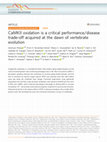
Nature Communications, 2021
Antagonistic pleiotropy is a foundational theory that predicts aging-related diseases are the res... more Antagonistic pleiotropy is a foundational theory that predicts aging-related diseases are the result of evolved genetic traits conferring advantages early in life. Here we examine CaMKII, a pluripotent signaling molecule that contributes to common aging-related diseases, and find that its activation by reactive oxygen species (ROS) was acquired more than half-a-billion years ago along the vertebrate stem lineage. Functional experiments using genetically engineered mice and flies reveal ancestral vertebrates were poised to benefit from the union of ROS and CaMKII, which conferred physiological advantage by allowing ROS to increase intracellular Ca2+ and activate transcriptional programs important for exercise and immunity. Enhanced sensitivity to the adverse effects of ROS in diseases and aging is thus a trade-off for positive traits that facilitated the early and continued evolutionary success of vertebrates.
Journal of Biological Chemistry, 2018
Biomarkers in Medicine, 2021
Aim: Evaluate the utility of glutamate dehydrogenase (GLDH) and cardiac troponin I as safety biom... more Aim: Evaluate the utility of glutamate dehydrogenase (GLDH) and cardiac troponin I as safety biomarkers, and creatine kinase and muscle injury panel as muscle health biomarkers in Duchenne muscular dystrophy. Patients & methods: Data were collected during a Phase II trial of domagrozumab. Results: GLDH was a more specific biomarker for liver injury than alanine aminotransferase. Cardiac troponin I elevations were variable and not sustained, limiting its applicability as a biomarker. Muscle injury panel biomarkers were no more informative than creatine kinase as a muscle health biomarker. Conclusion: Results support the use of GLDH as a specific biomarker for liver injury in patients with Duchenne muscular dystrophy. Clinical trial registration: ClinicalTrials.gov , NCT02310763 .
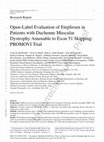
Journal of Neuromuscular Diseases, 2021
Background Eteplirsen received accelerated FDA approval for treatment of Duchenne muscular dystro... more Background Eteplirsen received accelerated FDA approval for treatment of Duchenne muscular dystrophy (DMD) with mutations amenable to exon 51 skipping, based on demonstrated dystrophin production. Objective To report results from PROMOVI, a phase 3, multicenter, open-label study evaluating efficacy and safety of eteplirsen in a larger cohort. Methods Ambulatory patients aged 7–16 years, with confirmed mutations amenable to exon 51 skipping, received eteplirsen 30 mg/kg/week intravenously for 96 weeks. An untreated cohort with DMD not amenable to exon 51 skipping was also enrolled. Results 78/79 eteplirsen-treated patients completed 96 weeks of treatment. 15/30 untreated patients completed the study; this cohort was considered an inappropriate control group because of genotype-driven differences in clinical trajectory. At Week 96, eteplirsen-treated patients showed increased exon skipping (18.7-fold) and dystrophin protein (7-fold) versus baseline. Post-hoc comparisons with patients ...

The FASEB Journal, 2021
Mitochondrial derangement is an important contributor to the pathophysiology of muscular dystroph... more Mitochondrial derangement is an important contributor to the pathophysiology of muscular dystrophies and may be among the earliest cellular deficits. We have previously shown that disruption of Mss51, a mammalian skeletal muscle protein that localizes to the mitochondria, results in enhanced muscle oxygen consumption rate, increased endurance capacity, and improved limb muscle strength in mice with wildtype background. Here, we investigate whether Mss51 deletion in the mdx murine model of Duchenne muscular dystrophy (mdx‐Mss51 KO) counteracts the muscle pathology and mitochondrial irregularities observed in mdx mice. We found that mdx‐Mss51 KO mice had increased myofiber oxygen consumption rates and an amelioration of muscle histopathology compared to mdx counterparts. This corresponded with greater treadmill endurance and less percent fatigue in muscle physiology, but no improvement in forelimb grip strength or limb muscle force production. These findings suggest that although Mss51 deletion ameliorates the skeletal muscle mitochondrial respiration defects in mdx and improves fatigue resistance in vivo, the lack of improvement in force production suggests that this target alone may be insufficient for a therapeutic effect.
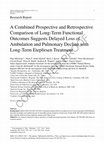
Journal of Neuromuscular Diseases, 2021
Background: Studies 4658-201/202 (201/202) evaluated treatment effects of eteplirsen over 4 years... more Background: Studies 4658-201/202 (201/202) evaluated treatment effects of eteplirsen over 4 years in patients with Duchenne muscular dystrophy and confirmed exon-51 amenable genetic mutations. Chart review Study 4658-405 (405) further followed these patients while receiving eteplirsen during usual clinical care. Objective: To compare long-term clinical outcomes of eteplirsen-treated patients from Studies 201/202/405 with those of external controls. Methods: Median total follow-up time was approximately 6 years of eteplirsen treatment. Outcomes included loss of ambulation (LOA) and percent-predicted forced vital capacity (FVC%p). Time to LOA was compared between eteplirsen-treated patients and standard of care (SOC) external controls and was measured from eteplirsen initiation in 201/202 or, in the SOC group, from the first study visit. Comparisons were conducted using univariate Kaplan-Meier analyses and log-rank tests, and multivariate Cox proportional hazards models with regressio...
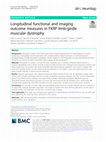
BMC Neurology, 2020
Background Pathogenic variants in the FKRP gene cause impaired glycosylation of α-dystroglycan in... more Background Pathogenic variants in the FKRP gene cause impaired glycosylation of α-dystroglycan in muscle, producing a limb-girdle muscular dystrophy with cardiomyopathy. Despite advances in understanding the pathophysiology of FKRP-associated myopathies, clinical research in the limb-girdle muscular dystrophies has been limited by the lack of normative biomarker data to gauge disease progression. Methods Participants in a phase 2 clinical trial were evaluated over a 4-month, untreated lead-in period to evaluate repeatability and to obtain normative data for timed function tests, strength tests, pulmonary function, and body composition using DEXA and whole-body MRI. Novel deep learning algorithms were used to analyze MRI scans and quantify muscle, fat, and intramuscular fat infiltration in the thighs. T-tests and signed rank tests were used to assess changes in these outcome measures. Results Nineteen participants were observed during the lead-in period for this trial. No significant...
Current Opinion in Neurology, 2020
Purpose of review Recent terminations of clinical trials of myostatin inhibitors in muscular dyst... more Purpose of review Recent terminations of clinical trials of myostatin inhibitors in muscular dystrophy have raised questions about the predictiveness of mouse models for this therapeutic strategy. Recent findings A variety of myostatin inhibitors have been developed for preclinical and clinical studies. These inhibitors have ameliorated the phenotype of many but not all mouse models of muscular dystrophy. However, randomized double-blinded placebo controlled trials in both pediatric and adult muscular dystrophies have, as of yet, not demonstrated functional improvement.
Neuromuscular Disorders, 2020
Randomized phase 2 trial and open-label extension of Randomized phase 2 trial and open-label exte... more Randomized phase 2 trial and open-label extension of Randomized phase 2 trial and open-label extension of domagrozumab in Duchenne muscular dystrophy. domagrozumab in Duchenne muscular dystrophy.
Journal of Clinical Investigation, 2020
JACC: Case Reports, 2020
A 24-year-old man with muscle cramps and a family history of sudden death presented with palpitat... more A 24-year-old man with muscle cramps and a family history of sudden death presented with palpitations. Electrocardiography showed signs of left ventricular hypertrophy and nonsustained ventricular tachycardia, and imaging studies confirmed hypertrophic cardiomyopathy. Genetic testing revealed a novel FHL1 mutation associated with Emery-Dreifuss muscular dystrophy. An implantable cardioverter-defibrillator was placed. (Level of Difficulty: Advanced.
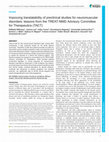
Disease Models & Mechanisms, 2020
Clinical trials for rare neuromuscular diseases imply, among other investments, a high emotional ... more Clinical trials for rare neuromuscular diseases imply, among other investments, a high emotional burden for the whole disease community. Translation of data from preclinical studies to justify any clinical trial must be carefully pondered in order to minimize the risk of clinical trial withdrawal or failure. A rigorous distinction between proof-of-concept and preclinical efficacy studies using animal models is key to support the rationale of a clinical trial involving patients. This Review evaluates the experience accumulated by the TREAT-NMD Advisory Committee for Therapeutics, which provides detailed constructive feedback on clinical proposals for neuromuscular diseases submitted by researchers in both academia and industry, and emphasizes that a timely critical review of preclinical efficacy data from animal models, including biomarkers for specific diseases, combined with adherence to existing guidelines and standard protocols, can significantly help to de-risk clinical programs...

CONTINUUM: Lifelong Learning in Neurology, 2019
PURPOSE OF REVIEW Facioscapulohumeral muscular dystrophy (FSHD) is a common muscular dystrophy af... more PURPOSE OF REVIEW Facioscapulohumeral muscular dystrophy (FSHD) is a common muscular dystrophy affecting both pediatric and adult patients. This article reviews the phenotype and pathophysiology of the disease as well as the recent efforts in clinical outcome measures and clinical trials. RECENT FINDINGS As the name implies, FSHD involves weakness of facial muscles, muscles that fix the scapula, and muscles overlying the humerus (biceps and triceps). The distinctive phenotype of FSHD occurs secondary to two different genetic mechanisms. FSHD type 1 (FSHD1) is due to a deletion on chromosome 4q, leading to hypomethylation and derepression of DUX4. FSHD type 2 (FSHD2) is due to mutations in SMCHD1 with resulting hypomethylation of the same subtelomeric region of chromosome 4q and derepression of DUX4. Understanding the central role of DUX4 has opened up the possibility of disease-modifying treatments. In preparation for clinical trials of novel agents, researchers are in the process of validating a number of clinical trial outcome measures including MRI, the 6-minute walk test, the FSHD Composite Outcome Measure, reachable workspace, electrical impedance myography, and the FSHD Health Index. SUMMARY The treatment of FSHD is currently supportive only. While past clinical trials in FSHD have been largely disappointing, novel agents in development, including antisense oligonucleotides, gene therapy, and small molecules, hold promise for future meaningful therapies.

Uploads
Papers by Kathryn R. Wagner